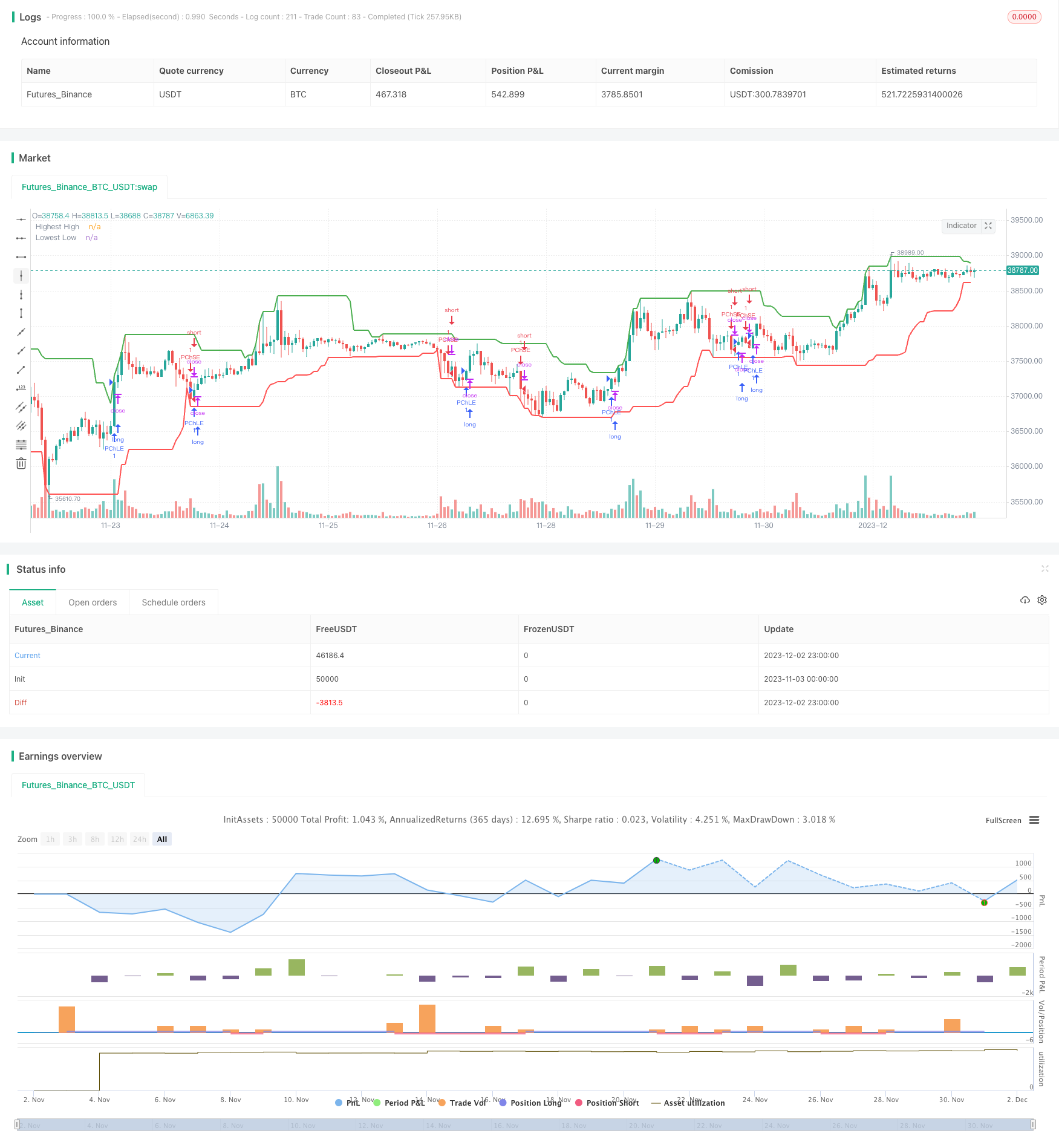
概述
该策略是一种基于平均真实范围(ATR)指标和平均方向指数(ADX)的自适应价格通道策略。它旨在识别价格运动中的盘整市场和趋势,并相应进行交易。
策略原理
计算最近length根K线的最高价(HH)和最低价(LL)。同时计算length根K线上的ATR。
根据价格的上涨和下跌计算+DI和-DI,再计算ADX。
如果ADX<25,则判断为盘整市场。此时如果收盘价高于价格通道上限(HH - ATR乘数*ATR),做多;如果收盘价低于价格通道下限(LL + ATR乘数*ATR),做空。
如果ADX>=25且+DI>-DI,则判断为牛市。此时如果收盘价高于价格通道上限,做多。
如果ADX>=25且+DI<-DI,则判断为空头市场。此时如果收盘价低于价格通道下限,做空。
进入仓位后,若超过exit_length根K线未止损,则强制止损平仓。
优势分析
该策略可自动适应市场环境。在盘整市场采用价格通道策略,在趋势市场跟随趋势方向交易。
ATR和ADX指标的运用确保了策略的自适应性。ATR用于调整价格通道的宽度,ADX用于判断市场趋势。
强制止损机制有助于策略的稳定性。
风险分析
ADX判断产生错误信号的概率较大。
ATR和ADX指标设置不当可能导致策略效果差。
无法有效规避行情突变的风险。
优化方向
优化ATR和ADX指标的参数,使自适应效果更好。
增加止损线以降低亏损风险。
增加 filter条件过滤错误信号。
总结
自适应价格通道策略综合运用多种指标和机制,在不同行情环境下采取不同策略,具有一定的自适应性和稳定性。但由于指标设置和参数选择的局限性,该策略也面临一定的误判风险。未来的优化方向在于参数优化、风险控制等方面。
策略源码
/*backtest
start: 2023-11-03 00:00:00
end: 2023-12-03 00:00:00
period: 1h
basePeriod: 15m
exchanges: [{"eid":"Futures_Binance","currency":"BTC_USDT"}]
*/
//@version=5
strategy("Adaptive Price Channel Strategy", overlay=true)
length = input(20, title="Length")
exit_length = input(10, title="Exit After X Periods")
atr_multiplier = input(3.2, title="ATR Multiplier")
startDate = input(defval = timestamp("2019-01-15T08:15:15+00:00"), title = "Start Date")
endDate = input(defval = timestamp("2033-04-01T08:15:00+00:00"), title = "End Date")
hh = ta.highest(high, length)
ll = ta.lowest(low, length)
atr = ta.atr(length)
// calculate +DI and -DI
upMove = high - high[1]
downMove = low[1] - low
plusDM = na(upMove[1]) ? na : (upMove > downMove and upMove > 0 ? upMove : 0)
minusDM = na(downMove[1]) ? na : (downMove > upMove and downMove > 0 ? downMove : 0)
plusDI = ta.rma(plusDM, length) / atr * 100
minusDI = ta.rma(minusDM, length) / atr * 100
// calculate ADX
dx = math.abs(plusDI - minusDI) / (plusDI + minusDI) * 100
adx = ta.rma(dx, length)
var int barSinceEntry = na
if (not na(close[length]) )
if (adx < 25) // Sideways market
if (close > hh - atr_multiplier * atr)
strategy.entry("PChLE", strategy.long, comment="PChLE")
barSinceEntry := 0
else if (close < ll + atr_multiplier * atr)
strategy.entry("PChSE", strategy.short, comment="PChSE")
barSinceEntry := 0
else if (adx >= 25 and plusDI > minusDI) // Bullish market
if (close > hh - atr_multiplier * atr)
strategy.entry("PChLE", strategy.long, comment="PChLE")
barSinceEntry := 0
else if (adx >= 25 and plusDI < minusDI) // Bearish market
if (close < ll + atr_multiplier * atr)
strategy.entry("PChSE", strategy.short, comment="PChSE")
barSinceEntry := 0
if (na(barSinceEntry))
barSinceEntry := barSinceEntry[1] + 1
else if (barSinceEntry >= exit_length)
strategy.close("PChLE")
strategy.close("PChSE")
barSinceEntry := na
plot(hh, title="Highest High", color=color.green, linewidth=2)
plot(ll, title="Lowest Low", color=color.red, linewidth=2)